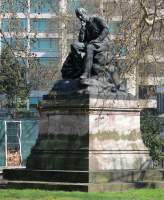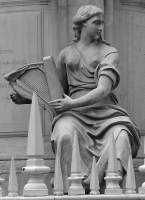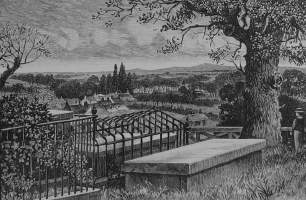
The bronze statue of the poet Byron, seated on a plinth of beautiful red and white marble – 57 tons of it presented by the Greek Government – is at the bottom of Park Lane, more or less behind Apsley House, on a sort of a roundabout. When the latest road scheme was designed, it may have seemed a good idea: Byron could be seen from all sides, and tourists on buses would get a fly-by view as the double-deckers swept around the statue. Some years on, the plane trees have grown, and tend to obscure the statue during the summer months from most aspects, and building work means there is currently no access to the roundabout to see Byron close up. So he is sculpture of the month for April, because by May he will be rather hidden by leaves.
The statue shows Byron seated in, well, Byronic pose, resting on one elbow, his thumb and forefinger supporting his chin, under his other hand, a book on his lap. But he is not reading, but lost in abstract thought, his eyes gazing into some private world. His face is noble, classical, that of an aesthete and a scholar (considered not a good likeness though), and his short, slightly curly hair shows his high and receding forehead, but his powerful neck, shoulder and upper body would seem those of a young athlete. To the left as we look from the front is his faithful dog, perhaps a sheepdog, woolly and faithful, seated by his master.
He wears contemporary clothes, with a shirt, bulky overshirt or coat with a casually looped scarf, and trousers over light shoes, but the looseness of his garments gives interesting folds and makes him almost appear in classical robes: he is seated on some cloak or robe too best viewed from the rear. For a rather nice view of this statue in the snow, see the bottom of this page.
The name of the sculptor appears on the base: 'R. C. Belt. Sc, London 1880'. Biographical notes on Belt tend to focus on a major libel case pitting him against the sculptor Charles B. Lawes, later Lawes-Wittewronge, supported by the magazine Vanity Fair: Belt was accused of not making his own sculpture, but that it was done by ‘ghost sculptors’, notably the young Thomas Brock, and Francois Verheyden (less familiar, but who has one notable work in London, which is a group of two reclining girls on the Royal Society of Painters in Watercolours building in Piccadilly - see this page). Belt won the case, and a follow-up case, which effectively bankrupted Lawes (though he later gained a rich inheritance), but there continued to be accusations that Belt’s signed statues were not his own. His oeuvre, whether or not by him in fact, included a variety of busts, and one other major London commission, which was the Queen Anne and four allegorical figures which stands in front of St Paul’s Cathedral. This latter group is apparently much inferior to the weathered originals by Francis Bird, which I have not seen, but certainly Bird produced some truly great work, among which my personal favourite is the reclining figure of Archbishop Sharp in York Minster. Here is one of the Bird allegorical figures, which looks to have suffered from overenthusiastic cleaning, perhaps after loss of the surface from the effects of pollution.
 Allegorical figure accompanying Queen Anne, in front of St Paul's.
Allegorical figure accompanying Queen Anne, in front of St Paul's.
The most admired statue of Byron is by Thorvaldsen, a sculptor of the first degree and considerably higher in the 19th Century pantheon than Belt, and who was also a contemporary of the poet, who died in 1824. Thorvaldsen’s marble figure is more coolly classical, but similarly has one hand holding a book (Belt would have been aware of the statue and its pose when composing his one), and in this case the other holds a pencil which rests against the poet’s chin, while he gazes into the distance rather than downward. On the base is an angelic figure with harp, the muse of poetry presumably. There are two copies of this statue: in Trinity College, Cambridge, and in Rome, in the Borghese gardens. Thorvaldsen also made a bust of Byron, which does not seem to particularly relate to the full figure, showing him with the curly hair and solid neck that Belt reproduced, but with a fuller face and cleft chin.
There are various other statues and busts of Byron. We should mention the one in Aberdeen Grammar School, a standing bronze by P. MacGillivray. We may also note a bust of Byron by Alfred Drury, a youthful figure, in a classical robe. And because of his importance in fighting for the freedom of the Greeks, there are statues of him there, most notably in Athens, though I do not know the sculptor.
One more Byron monument I wish to mention – in Harrow, on the hill by the parish church, among the tombs, by one conspicuous one covered with a grill, to someone called Peachey, was the place which the young Byron described as his favourite spot. Still today, the view is rather splendid. A large plaque at the site quotes from one of his poems.
 Byron monument and view from Harrow on the Hill
Byron monument and view from Harrow on the Hill
Back to Belt’s Byron to consider its surroundings. A couple of massive pieces of sculpture are nearby. On top of Constitution Arch just to the south is Peace in her Quadriga, by Adrian Jones, one of only two full scale bronze groups of a chariot with horses in London. In the same open space are the equestrian Wellington by J. E. Boehm, war memorials by Derwent Wood and C. Sergeant Jagger, and modern memorials. And just within Hyde Park, more or less where Byron is facing, is the gargantuan statue of Achilles, the Wellington monument, by Richard Westmacott RA, and another work by Adrian Jones, which is the Cavalry monument. All these are described on this page. Close by is the Diana Fountain by Feodora von Gleichen, subject of another page on this site. Finally, heading opposite down Piccadilly, unpromising at this end, is a fine crop of architectural sculpture further along, noted on this page.
Previous month (March 2012) // Next month (May 2012)
Sculptors // Sculpture in London
Visits to this page from 13 Mar 2014: 12,931